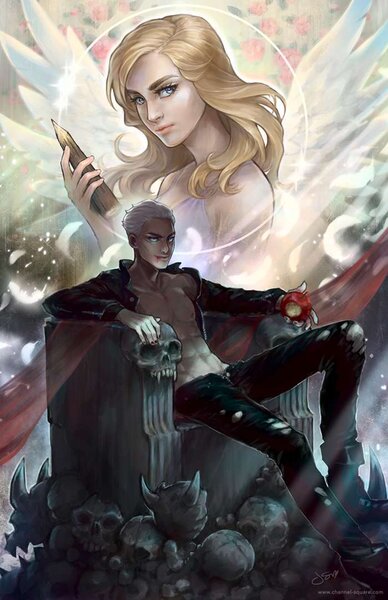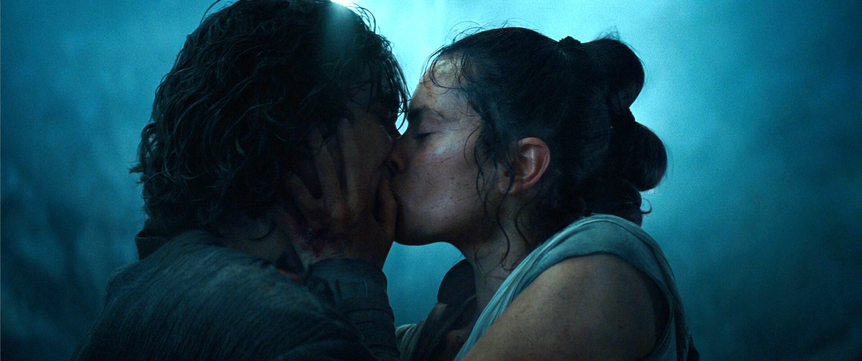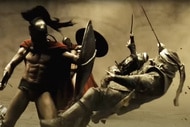Origins of Fanfiction Tropes: 'Enemies-To-Lovers' is a trope readers love to hate and hate to love

Welcome to Read This Fanfiction, a monthly deep dive into the world of fic: its history, its future, and all its splendors. In the world of fanfiction there are tropes — common themes and storylines that writers and readers flock to, be it out of interest or a desire to scratch a specific itch. From hurt/comfort to University AU, these tropes are popular for a reason. But where do they come from, and what about them resonates so deeply? This month, as part of our Origins of Fanfiction series, SYFY WIRE explores the origins of enemies-to-lovers and how its perception in modern media is in flux.
When two characters really hate each other — driving up the drama and the banter and the suspense — it makes for some good media. The tumultuous relationship trajectory of Han and Leia, or say, The 100’s Clarke and Lexa, are perfect examples. Not to mention the delightful revelation that was Catra and Adora in She-Ra. They showed us that sometimes you just need a little push to make you realize the emotion you’re feeling isn’t hatred. It’s an age-old trope hundreds of years in the making.
There are just over 53,000 works tagged enemies-to-lovers on Archive of Our Own — stories of people going from viciously hating each other to sharing the same bed. Sometimes there are pit stops in between, but the trajectory is much the same: You hate someone until the second you realize you love them.
Modern examples include Buffy Summers and Spike from Buffy the Vampire Slayer, Emma Swan and Captain Hook from Once Upon a Time, and Will Graham and Hannibal Lecter from Hannibal. Canon or not, they all have one thing in common: Boy, did they hate each other.
BREAKING DOWN THE ENEMIES AND LOVERS
Often dramatic and sometimes tragic, the enemies-to-lovers trope is as complex as it is simple; there are many iterations and versions.
Enemies-to-Friends-to-Lovers is a subtag on Ao3, and as such is a derivative of the trope, taking the flip from hate to love a bit slower for an arguably more realistic (but still self-explanatory) turn. However, when it comes down to it, there are certain features that must be present to truly belong to the trope.
Dr. Lori Morimoto is an independent researcher of fan culture whose work has been featured in everything from Becoming: Genre, Queerness and Transformation in NBC’s Hannibal to A Companion to Media Fandom and Fan Studies. To her, enemies-to-lovers can go one of two ways.
“One is stories that center on characters whose antipathy is so palpable that it lends itself to reworking as heated passion; the other, oftentimes, but not always, related to the first, is centered on characters whose animosity comes from some fundamental misunderstanding,” Morimoto tells SYFY WIRE.
The latter is most famously presented in Jane Austen’s Pride and Prejudice between Elizabeth Bennet and Mr. Darcy, who are a fine example of how a relationship can move from enemies to eventual lovers. Elizabeth, once slighted, finds her hatred of Mr. Darcy grows once he destroys her sister’s relationship, only for her to grow to appreciate him as he saves her family from ruin and softens his manner toward her.
“For me, what needs to be front and center is a very real sense of animosity at the beginning,” Morimoto tells SYFY WIRE. “I don’t think such fic needs to include Heathcliff/Cathy levels of toxic passion,” she continues, referencing his disdain for her as she marries someone else and their violent fights with one another, “… but the sense that these two really kind of hate each other from the outset should be palpable.”
Dr. Ashley D. Polasek, who holds a Ph.D in adaptation studies, is inclined to agree, though she stipulates that any literary trope should be defined fairly broadly.
“I’d describe [enemies-to-lovers] as a story in which two characters begin in a non-romantic, antagonistic relationship and, through some circumstance of the narrative, move into a romantic relationship that may or may not remain antagonistic,” she explains.
MUCH ADO ABOUT ENEMIES-TO-LOVERS
There is perhaps no more legendary journey of enemies to lovers than that of Beatrice and Benedick of William Shakespeare’s Much Ado About Nothing. While not the earliest example of the trope in Western literature, that privilege goes to Gareth and Lynette from Sir Thomas Malory's Le Morte d'Arthur from 1485, it is perhaps the most distinct.
It is established very early on in the play that the two characters have a mutual dislike of one another, most commonly expressed by their eviscerating verbal sparring. It’s a dislike so profound that their friends decide they wish to play the biggest prank of them all and convince them both that their sworn enemy is actually madly in love with them.
“It is only the cover of believing that they are returning love rather than initiating it that allows them to consider a romantic relationship,” Polasek explains.
BENEDICK: It seems her affections have their full bent. Love me? Why, it must be requited! (Much Ado II.iii)
BEATRICE: Benedick, love on; I will requite thee, taming my wild heart to thy loving hand. And if thou dost love, my kindness shall incite thee to bind our loves up in a holy band. (Much Ado III.i)
What truly cements the switch from enemies to lovers, however, are not the tricks. Instead, it is the wronging of Beatrice’s cousin Hero by Benedick’s best friend Claudio. When he agrees to challenge him to a duel to prove his love for her, their relationship is forever changed.
“In agreeing, Beatrice and Claudio effectively switch roles in Benedick’s life. The enemy becomes the lover, the bosom friend becomes the enemy,” Polasek explains. In this, we have the model for all great enemies-to-lovers couples.
“Their initial antagonism is cutting. The mechanism that drives them to consider romance is well executed. The circumstance that ultimately binds them in love has high enough stakes that the transition is believable,” she adds.
What is key here is that even as lovers, Beatrice and Benedick maintain the same elements that defined them as enemies in the first place. They still bicker even as they marry. For Polasek’s part, there is no couple more compelling as enemies-to-lovers, or as a whole.
“Give me a single one of their scenes over the whole of Romeo and Juliet’s relationship,” she raves. “Is it any wonder that writers have been drawing from this same well for the last 400 years?”
ABUSE AND CATHARSIS IN ENEMIES-TO-LOVERS
Any relationship that begins or is defined by hatred will have dark elements to it. Abuse has long been part of the conversation when it comes to enemies-to-lovers couples and stories. It may feature heavily or be more subtle, and this abuse can manifest itself in many ways, from microaggressions or sneers to flat-out racial attacks.
“There are kinds of fic in which abuse is racialized, and there are exceedingly few — if any — contexts in which that can be attributed to seeking comfort or healing,” Morimoto explains. “Simply put, I don’t think all enemies-to-lovers fic is created equally, and I think our preoccupation with uneven power dynamics has lent itself to the wholesale criticism of this kind of fic, where it both is and isn’t warranted.”
To say it’s nuanced would still be oversimplifying it. There have long been discussions online about what is appropriate and what isn’t. Is romanticizing any type of power imbalance or emotional, mental, or physical abuse welcome in the fanfiction community? Some people have an unmovable stance, but drawing a hard line isn’t the answer, nor is it productive. In most cases.
“Fanfiction culture right now is very much mired in issues of what’s realistic, what’s healthy, and how fic may reinforce or even cultivate unhealthy, sexist, or racist thinking in readers,” Morimoto explains, pointing to ships such as those involving Star Wars character Kylo Ren as being particularly susceptible to this type of judgment.
“Criticism tends to focus on the fact that [Kylo Ren] is, narratively, a Bad Man. He’s part of a fascist regime, and it’s difficult to reconcile that with romance; it also lends itself to criticism of romanticizing fascism, excusing the ‘misunderstood’ bad guy,” she adds.
That said, Reylo (Rey/Kylo Ren) and Kylux (Kylo Ren/General Hux) are both extremely popular ships, with the former frequently finding itself the subject of this debate. Is the relationship between Rey and Kylo Ren abusive as an enemies-to-lovers trope, or is there a character development arc that closes that gap as he unlearns abusive behaviors?
Morimoto doesn’t believe that one’s taste in fanfiction or the desire to write dark stories should be generalized as bad just because of how it depicts abuse. It’s something Polasek agrees firmly with. She sees literature as humanity’s method of trying to make sense of the human condition. (And yes, she considers fanfiction to be literature.)
“The human condition is complex and varied, and it includes an unimaginable variety of experiences. Each of us will only ever live a fraction of those experiences, but we can work to understand the larger range of them through literature,” Polasek explains. “As readers, we can elect not to live through someone else’s experiences by choosing not to read literature that we don’t wish to read, but I don’t think it’s our place to tell people they can’t work to make sense of themselves in their own writing. We only ever learn and grow through access to more information—more literature, more art, more analysis, more commentary—never less.”





























